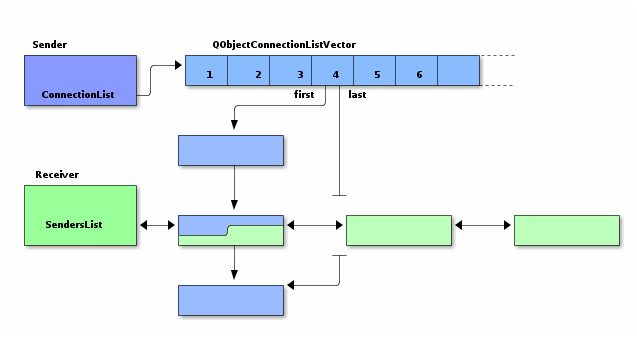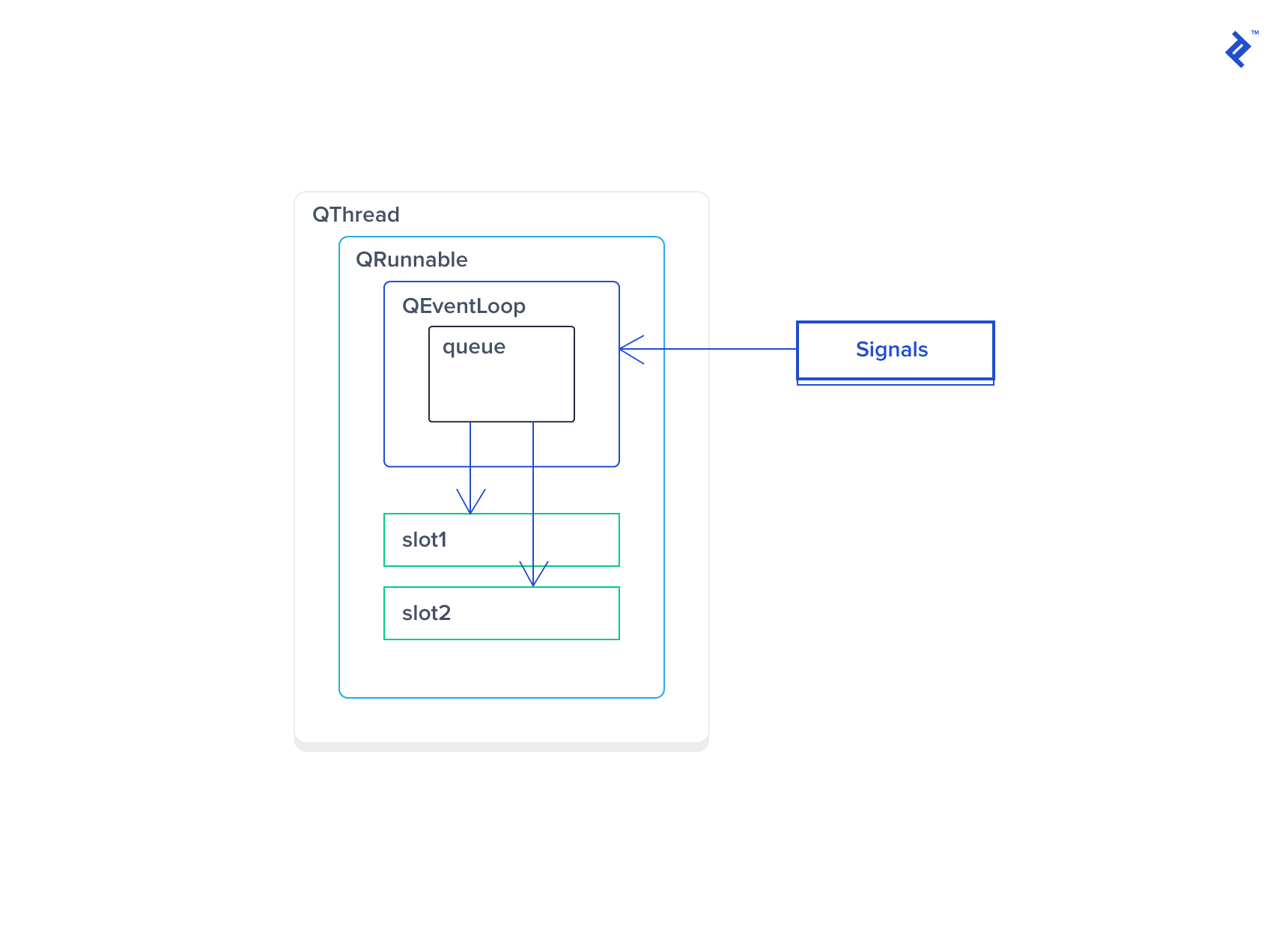Pyqt Signals And Slots Across Threads
PyQt4 has a unique signal and slot mechanism to deal with events. Signals and slots are used for communication between objects. A signal is emitted when a particular event occurs. A slot can be any Python callable.
Python multiprocessing¶
In lesson 4 of the tutorial, we launched a separate python interpreter running a client program that was using decoded and shared frames.
Each PyQt widget, which is derived from QObject class, is designed to emit ‘ signal ’ in response to one or more events. The signal on its own does not perform any action. Instead, it is ‘connected’ to a ‘ slot ’. The slot can be any callable Python function. PyQt5 signals and slots Graphical applications (GUI) are event-driven, unlike console or terminal applications. A users action like clicks a button or selecting an item in a list is called an event. If an event takes place, each PyQt5 widget can emit a signal. New customer offer. Place 5 x £10 or more bets to receive Qt Signals And Slots Across Threads £20 in free bets. Repeat up to 5 times to receive maximum £100 bonus. Min odds 1/2 (1.5). Signals And Slots Across Threads Qt Neteller do not qualify for this bonus offer. The bonus offer is Signals And Slots Across Threads Qt available to players from: Andorra, Gibraltar, Malta, Iceland, Liechtenstein, Monaco and Luxembourg. Players must wager the bonus amounts Signals And Slots Across Threads Qt 35 times. 18+, New Players Only.
That approach works for Qt programs as well, but it is more convenient to use multiprocesses constructed with python3’s multiprocessing library.
Using python multiprocesses in a Qt program complicates things a bit, but not that much. We simply need a way to map from events taking place at the separate and isolated multiprocess into signals at the main Qt program. This can be done by communicating with the python multiprocess via pipes and converting the pipe messages into incoming and outgoing Qt signals.
Let’s state that graphically:
Note that we only need a single QValkkaThread to control several multiprocesses.
Let’s dig deeper into our strategy for interprocess communication with the Qt signal/slot system:
The class valkka.multiprocess.MessageProcess provides a model class that has been derived from python’s multiprocessing.Process class.In MessageProcess, the class has both “frontend” and “backend” methods.
Frontend methods can be called after the process has been started (e.g. after the .start() method has been called and fork has been performed),while backend methods are called only from within the processes “run” method - i.e. at the “other side” of the fork, where the forked process lives in its own virtual memory space.
A signalling scheme between back- and frontend is provided in the MessageProcess class. Don’t be afraid - the MessageProcess class is just a few lines of python code!
To make starting easier, two stripped-down sample programs are provided in:
Try them with python3 to see the magic of python multiprocesses connecting with the Qt signal/slot system.
Finally, for creating your own Qt application having a frontend QThread, that controls OpenCV process(es), copy the following file into your own module:
It contains:
QValkkaProcess (a general multiprocess class with Qt signals)
QValkkaOpenCVProcess (multiprocess with Qt signals and OpenCV)
QValkkaThread (the frontend QThread) that you can use in your own applications.
Consult the test_studio_.py* programs how to use these classes.
A more full-blown multiprocess orchestration example can be found as a separate python package, from here.
This section describes the new style of connecting signals and slotsintroduced in PyQt v4.5.
One of the key features of Qt is its use of signals and slots to communicatebetween objects. Their use encourages the development of reusable components.
A signal is emitted when something of potential interest happens. A slot is aPython callable. If a signal is connected to a slot then the slot is calledwhen the signal is emitted. If a signal isn’t connected then nothing happens.The code (or component) that emits the signal does not know or care if thesignal is being used.
The signal/slot mechanism has the following features.
- A signal may be connected to many slots.
- A signal may also be connected to another signal.
- Signal arguments may be any Python type.
- A slot may be connected to many signals.
- Connections may be direct (ie. synchronous) or queued (ie. asynchronous).
- Connections may be made across threads.
- Signals may be disconnected.
Unbound and Bound Signals¶
A signal (specifically an unbound signal) is an attribute of a class that is asub-class of QObject. When a signal is referenced as an attribute of aninstance of the class then PyQt automatically binds the instance to the signalin order to create a bound signal. This is the same mechanism that Pythonitself uses to create bound methods from class functions.
A bound signal has connect(), disconnect() and emit() methods thatimplement the associated functionality. It also has a signal attributethat is the signature of the signal that would be returned by Qt’s SIGNAL()macro.
A signal may be overloaded, ie. a signal with a particular name may supportmore than one signature. A signal may be indexed with a signature in order toselect the one required. A signature is a sequence of types. A type is eithera Python type object or a string that is the name of a C++ type.
If a signal is overloaded then it will have a default that will be used if noindex is given.
When a signal is emitted then any arguments are converted to C++ types ifpossible. If an argument doesn’t have a corresponding C++ type then it iswrapped in a special C++ type that allows it to be passed around Qt’s meta-typesystem while ensuring that its reference count is properly maintained.
Defining New Signals with pyqtSignal()¶
PyQt automatically defines signals for all Qt’s built-in signals. New signalscan be defined as class attributes using the pyqtSignal()factory.
Create one or more overloaded unbound signals as a class attribute.
| Parameters: |
|
|---|---|
| Return type: | an unbound signal |
The following example shows the definition of a number of new signals:
New signals should only be defined in sub-classes of QObject.
New signals defined in this way will be automatically added to the class’sQMetaObject. This means that they will appear in Qt Designer and can beintrospected using the QMetaObject API.
Overloaded signals should be used with care when an argument has a Python typethat has no corresponding C++ type. PyQt uses the same internal C++ class torepresent such objects and so it is possible to have overloaded signals withdifferent Python signatures that are implemented with identical C++ signatureswith unexpected results. The following is an example of this:
Connecting, Disconnecting and Emitting Signals¶
Signals are connected to slots using the connect() method of a boundsignal.


Connect a signal to a slot. An exception will be raised if the connectionfailed.

| Parameters: |
|
|---|
Signals are disconnected from slots using the disconnect() method of abound signal.

Disconnect one or more slots from a signal. An exception will be raised ifthe slot is not connected to the signal or if the signal has no connectionsat all.
| Parameters: | slot – the optional slot to disconnect from, either a Python callable oranother bound signal. If it is omitted then all slots connected to thesignal are disconnected. |
|---|
Signals are emitted from using the emit() method of a bound signal.
Emit a signal.
| Parameters: | args – the optional sequence of arguments to pass to any connected slots. |
|---|
The following code demonstrates the definition, connection and emit of asignal without arguments:
The following code demonstrates the connection of overloaded signals:
Connecting Signals Using Keyword Arguments¶
It is also possible to connect signals by passing a slot as a keyword argumentcorresponding to the name of the signal when creating an object, or using thepyqtConfigure() method of QObject. For example the following threefragments are equivalent:
The pyqtSlot() Decorator¶
Although PyQt allows any Python callable to be used as a slot when connectingsignals, it is sometimes necessary to explicitly mark a Python method as beinga Qt slot and to provide a C++ signature for it. PyQt provides thepyqtSlot() function decorator to do this.
Decorate a Python method to create a Qt slot.

| Parameters: |
|
|---|
Connecting a signal to a decorated Python method also has the advantage ofreducing the amount of memory used and is slightly faster.
For example:
It is also possible to chain the decorators in order to define a Python methodseveral times with different signatures. For example:
Connecting Slots By Name¶
PyQt supports the QtCore.QMetaObject.connectSlotsByName() function thatis most commonly used by pyuic4 generated Python code toautomatically connect signals to slots that conform to a simple namingconvention. However, where a class has overloaded Qt signals (ie. with thesame name but with different arguments) PyQt needs additional information inorder to automatically connect the correct signal.
Pyqt Signals And Slots Across Threads Onto
For example the QtGui.QSpinBox class has the following signals:
When the value of the spin box changes both of these signals will be emitted.If you have implemented a slot called on_spinbox_valueChanged (whichassumes that you have given the QSpinBox instance the name spinbox)then it will be connected to both variations of the signal. Therefore, whenthe user changes the value, your slot will be called twice - once with aninteger argument, and once with a unicode or QString argument.
This also happens with signals that take optional arguments. Qt implementsthis using multiple signals. For example, QtGui.QAbstractButton has thefollowing signal:
Pyqt Signals And Slots Across Threads Crossword
Qt implements this as the following:
The pyqtSlot() decorator can be used to specify which ofthe signals should be connected to the slot.
For example, if you were only interested in the integer variant of the signalthen your slot definition would look like the following:
Pyqt Signals And Slots Across Threads Game
If you wanted to handle both variants of the signal, but with different Pythonmethods, then your slot definitions might look like the following:
The following shows an example using a button when you are not interested inthe optional argument:
Mixing New-style and Old-style Connections¶
Pyqt Signals And Slots Across Threads Free
The implementation of new-style connections is slightly different to theimplementation of old-style connections. An application can freely use bothstyles subject to the restriction that any individual new-style connectionshould only be disconnected using the new style. Similarly any individualold-style connection should only be disconnected using the old style.
You should also be aware that pyuic4 generates code that usesold-style connections.